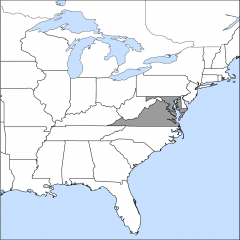Basic Woodland (Central Appalachian)
Learn More
Where to Explore It
In the Basic Woodland, stunted white ash and pignut hickory are widely spaced on grassy slopes. This natural community is rare because it depends on an unusual combination of factors: sunny exposed sites with dry yet fertile soil. (There is more than one type of Basic Woodland; this one is found in the Central Appalachians.)
The Basic Woodland is found in dry, rocky, fertile soil on exposed slopes in the Central Appalachians.
The range map shows the states in which this natural community has been documented.
More About This Natural Community
The Basic Woodland consists of grassy, rocky slopes sparsely dotted with stunted white ash and pignut hickory, red hickory, and shagbark hickory. A great variety of grasses, sedges, and wildflowers flourish here, including Pennsylvania sedge, small-flower phacelia, elmleaf goldenrod, woodland sunflower, and hoary mountainmint.
The soil is thin, rocky, and dry, but it is also fertile due to high amounts of calcium and other base minerals provided by the underlying bedrock.
For a more in-depth look at this community, click on a link under “Where to Explore It.”
Look for It in These National Parks
- Appalachian Trail (Central Appalachians)
- Blue Ridge Parkway
- Catoctin Mountain Park
- Chesapeake and Ohio Canal National Historical Park
- Harpers Ferry National Historical Park
- Shenandoah National Park
Conservation Status
How vulnerable is a natural community? Is it at risk of elimination? Learn about conservation status.
Classification
Official names reduce confusion by providing a common language for talking about natural communities. Why so many names?



